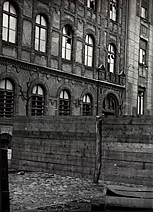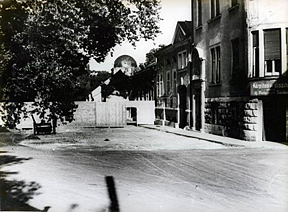Humane Officials
From the first Anti-Jewish Law (1938), the Hungarian administrative apparatus became accustomed to the fact that the Jews were secondary citizens, and it was the official duty of the whole administrative body - from the minister to the village notary - to confront them. Depriving Jews of the right to vote, of their membership in municipal authorities and teaching staffs, and confiscating their land and professional licenses were only a matter of official paperwork. Thus, it is not surprising that their total plunder, ghettoization and deportation did not signify a major difference to the larger part of the administrative body. The administration completed its tasks efficiently, smoothly solving the logistical problems that unavoidably were brought on by the "dejewification" process. There were only a few who tried to carry out the orders in a humane way, let alone to save the Jews. Still, there were such cases.
W. I. from Munkács remembered: "following the arrival of the Germans, compared to other regions, orders were not strictly enforced in our city, thanks to the notary; the Jews were treated with some leniency".[1] L. Zs., a survivor from Mezőcsát reported that Chief Constable László Papp "carried out orders with reluctance; he could not be blamed".[2]
Besides the law enforcement agencies, the administrative apparatus predominantly selected the site of the ghettoes and collection camps,
 |
Fence of the Szeged ghetto |
In Békéscsaba, despite the strong antisemitic sentiment of the general population, "one could not complain about Mayor Gyula Jánossy", remembered E. K.[3]
The night before the ghettoisation, the notary of Nagybereg summoned the prominent members of the Jewish community and sent the message to the Jews of the town that the next day they would be transported to the ghetto in Beregszász. "He advised us in secret to give us a chance to pack up... [The next day the gendarmes] gave us ten minutes to pack our belongings ..."[4]
Károly Mihály and his family were taken to the ghetto in Mohács from Pécsvárad. In Mohács initially "the ghetto was not even fenced in. In most cases the food came from a public kitchen. We had no work, although in the mornings the women had to clean for the German army."[5]
In Perecsény, Carpatho-Ruthenia, many complained about the notary, while "Chief Notary Pukán [Sándor] and Chief Constable Margittai [Endre] were more compassionate, they endeavoured to protect the Jews, but the popular sentiment was so strong against the Jews that they could not do anything for them".[6]
While in the Aknaszlatina ghetto the gendarmes beat the Jews, "one could not complain about the local notary [his name was Csaba]; under the circumstances, he tried what he could to help the Jews." The indulgent notary arranged for the local Jews not to be removed from their homes and to stay a few more weeks in the village.[7]
S. G. and S. E. described conditions in the Vác ghetto in positive terms. "In general, we did not have it too
Plank fence of the Paprét ghetto in Sopron
bad". "We had enough space. The ghetto was not under strict guard, so we could go to the market and leave the area any time. Each family could care for itself. If we could only have lasted like this until liberation." Both witnesses ended up in Auschwitz-Birkenau, and both lost their families.[8]

According to one survivor, the chief constable of Alsóverecke simply refused to hand over the Jews of the village. Allegedly the gendarmes deported him as well.[9]
One finds many positive examples in the outskirts of Budapest, all the more surprising because administratively these districts belonged to Pest-Pilis-Solt-Kiskun County where, between January 1938 and March 1944, László Endre acted as sub-prefect, who, following his April appointment as State Secretary and Eichmann's key associate, supervised the "dejewification" of the country.
In Csepel the ghetto was not segregated from the rest of the population. Jews were moved to buildings scattered in different parts of the town. "This was more convenient, because this way these buildings could not be so isolated and we had a chance to move about freely." Although the Jews were made to move several times, "we had no other difficulties" remembered B. M.[10]
In Újpest, according to the unanimous testimonies of Mrs Jenő Weisz and her daughter and Dr L. I., the authorities behaved humanely when the ghetto was organized. "We could come and go, and take anything inside."[11] "We had a normal life there; with the exception of the last three days we could come and go."[12] On the other hand, according to another survivor in Újpest "antisemitic decrees ... especially making people move together, were executed the most cruelly by the councillor of the city hall called Bakó".[13]
Initially, János Pető, mayor of Szentendre tried to sabotage the establishment of the ghetto. "He reported to László Endre that due to lack of an appropriate area the ghetto could not be set up. Endre called him personally by telephone telling him that unless the ghetto were established, he would be suspended from his job", remembered Miklós Vas, who, as a member of the Jewish Council of Szentendre, was familiar with the tug-of-war surrounding the ghettoisation process.[14] Pető decided to stay on the job and attempt to carry out orders as humanely as possible. As a result, despite serious overcrowding, conditions in the Szentendre ghetto were tolerable. "The ghetto did not have a commander. It was not even enclosed. They set aside a block of buildings for us without fencing. ... We had it relatively easy in there."[15]
Mayor of Kispest Dr József Molnár tried passive resistance to sabotage the implementation of ordinances issued by the collaborating Sztójay government. Had it been left up to him, the Jews of Kispest would have been saved. "Ordered by László Endre, Dr József Molnár carried out the anti-Jewish ordinances. It was due to Molnár that Kispest was the last of all places near Budapest where a ghetto was made. Compared to other places, we were housed under relatively normal conditions. No one guarded the territory of the ghetto. We had the opportunity to run errands up to the last minute. Everyone was allowed to go to the market and each family could provide for itself" is how Miklós Szalai described local conditions.[16]
"On March 19, 1944 Dr József Molnár was the Mayor of Kispest. Both he and the local police captain treated Jews decently. Forced communal living [i.e., ghettoisation] started in mid May. The ghettoisation issue was handled humanely, thanks exclusively to the mayor's kind disposition", recounted Mrs. H. P, a survivor of Auschwitz.[17]
Mrs K. L remembered Dr József Molnár as follows: "We had a very decent mayor in Kispest; he did everything [18]
Referring to overcrowding in the Balassagyarmat ghetto "Dr Albert Kenessey issued a memorandum to legal authorities ..., protesting the excessive crowding of the population citing public health reasons". Recognizing the danger of epidemics, other doctors urged mandatory inoculation against typhoid fever. On May 22, the sub-prefect of Nógrád County ordered the mandatory vaccination of the Jews in all the ghettos of the county. Local authorities had to advance the cost of the vaccine "with the right of recourse against Jewish assets", which meant the costs were covered by the Jews.[19] Military authorities held frequent recruitment drives in ghettos, "as a result of which all healthy males between the ages of 16 and 48 were called up for labour service. Thus, the ghetto was left with boys under 16, men over 48, women and the ill. However, women were also taken away ..., in larger groups, they were assigned for farm work. It appeared that the authorities tried to spare them from being deported."[20], wrote a member of the Jewish Council in Balassagyarmat, and he was probably right. The Germans protested on several occasions to Sztójay, claiming that military authorities ordered Jews to labour service immediately before deportation.
In Csillaghegy the chief notary, the municipal judge and gendarme commander László Endre carried out the ghettoisation order as humanely as possible. After locating the ghetto in three buildings in Zenta Street-locally known as the "leper colony"-representatives of the community protested, claiming there was not enough space. As Chief Notary Sólymosi and Constable György Katzinger accepted their argument, with the chief constable's permission they expanded the ghetto by including a building suitable for housing a large number of people. In fact secretly, without the Chief Constable's knowledge, two other buildings were placed at the community's disposal. Moreover, "thanks to the local authorities, two hundred and twenty-four people were allowed to move to Budapest even before the establishment of the ghetto".[21]
It would have been an obvious survival technique to buy the "goodwill" of the authorities; this however-based
 |
Fence of the Debrecen ghetto |
It was often the case that while some members of the administration were sympathetic to the plight of the Jews, they did not have the courage to risk sabotaging antisemitic ordinances, much less to resist or intervene in any active way. When Jewish men in the village of Alsókalocsa complained to Notary Zoltán about looting gendarmes, "he showed understanding but said he could not do anything for them".[24] Members of the Jewish Council of Mátészalka had the same experience.[25]
Isolated cases of resistance among members of the state administration took the form sabotaging antisemitic decrees and/or their execution in a humane manner. We have not seen any cases of active rescue efforts. The picture emerging after examining the DEGOB-protocols matches the analysis provided by political philosopher István Bibó: "...Even the more humane members of the public administration operated under the illusion of executing the legitimate orders of a legitimate government that led to various acts of horror only at the hands of brutal and aggressive enforcement bodies ... Very few came to view the state's executive power as a band of gangsters, its ordinances as trash and disobedience, and deception and forgery in response as their moral duty."[26]
Footnotes
[1] Protocol 1585.
[2] Protocol 3055.
[3] Protocol 3216.
[4] Protocol 522.
[5] Protocol 3476.
[6] Protocol 1859.
[7] Protocol 1541.
[8] Protocol 1146., Protocol 3554.
[9] Protocol 1375.
[10] Protocol 1126.
[11] Protocol 2448.
[12] Protocol 2719.
[13] Protocol 3588
[14] Protocol 3594.
[15] Protocol 29., Protocol 3592.
[16] Protocol 1617.
[17] Protocol 3241.
[18] Protocol 3124.
[19] Sub-Prefect's Decree no. 10.334/1944. May 22, 1944. Tyekvicska 1995, p. 93.
[20] Protocol 3550.
[21] Protocol 3496.
[22] Braham 1997, pp. 430-488.; Lévai 1948, pp. 79-83.
[23] Protocol 1140.
[24] Protocol 1610.
[25] Protocol 79.
[26] Bibó 1984, p. 153.
References
Bibó1984
István Bibó: Zsidókérdés Magyarországon 1944 után. (Jewish Question in Hungary after 1944.) In Hanák Péter (ed.): Zsidókérdés, asszimiláció, antiszemitizmus. (Jewish Question, Assimilation, Anti-Semitism.) Budapest, 1984, Gondolat. pp. 135-294.
Braham 1997
Randolph L. Braham: A népirtás politikája - a Holocaust Magyarországon. (The Politics of Genocide. The Holocaust in Hungary.) Vols. 1-2. Budapest, 1997, Belvárosi Könyvkiadó.
Lévai 1948
Jenő Lévai: Zsidósors Magyarországon. (Jewish Fate in Hungary.) Budapest, 1948, Magyar Téka.
Tyekvicska 1995
Árpád Tyekvicska (ed.): Adatok, források, dokumentumok a balassagyarmati zsidóság holocaustjáról. (Data, Sources, Documents on the Holocaust of the Jewry of Balassagyarmat.) Annual of the Nagy Iván Történeti Kör. Balassagyarmat, 1995, Nagy Iván Történeti Kör.

